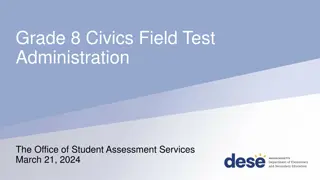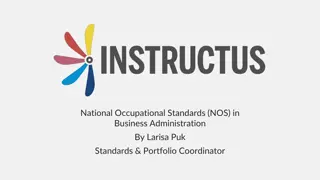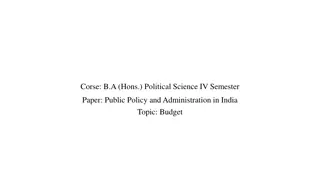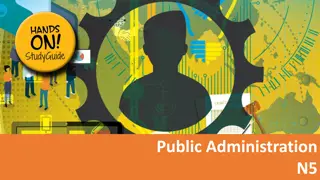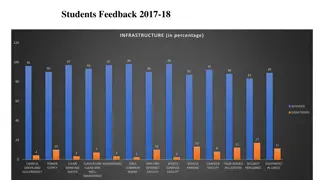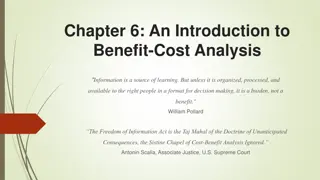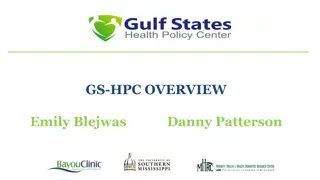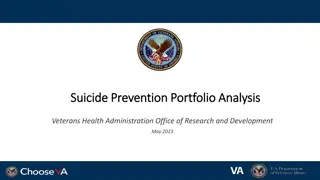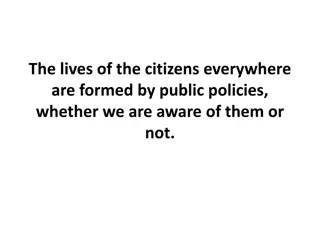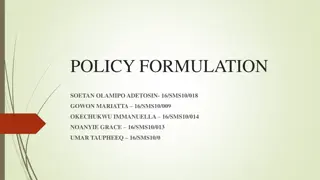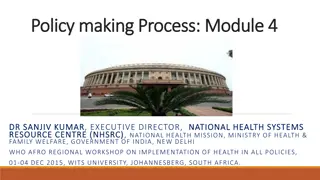Understanding Policy Analysis Process in Health Administration
Policy analysis involves providing informed advice to clients on public policy decisions, including recommended courses of action based on identified issues and problem statements. This process entails defining the problem, exploring options, and making recommendations to address public policy challenges effectively. Key elements include issue statements, problem analysis, and formulating recommendations to guide decision-making in the healthcare sector.
Download Presentation

Please find below an Image/Link to download the presentation.
The content on the website is provided AS IS for your information and personal use only. It may not be sold, licensed, or shared on other websites without obtaining consent from the author. Download presentation by click this link. If you encounter any issues during the download, it is possible that the publisher has removed the file from their server.
E N D
Presentation Transcript
HEALTH ADMINISTRATION & POLICY Class 4 Policy Analysis (edited/adapted from original 4/30/21 KGN) Professor: K. Noonan | TA: B. Nabet PUBH 505: Spring 2017 1
WHAT IS A POLICY ANALYSIS Informed advice to a client that relates to a public policy decision, includes a recommended course of action/inaction, and is framed by the client s powers and values 2
ELEMENTS OF POLICY ANALYSIS Essential elements of the analysis Issue Statement/Problem Statement (Bardach elements) Background Landscape Options Recommendation 3
PROBLEM ANALYSIS: ISSUE STATEMENT Defining the problem Identify the conditions What are you examining? Describe the set of conditions that are under examination. Broad or narrow? Issue statement Short statement (2-3 sentences) summarizing the issue to be considered. Ideally, phrase the problem in the form of a question to guide your selection of information to include. Provide some context by identifying the conditions creating the problem in an introductory sentence or clause. 4
ISSUE/PROBLEM STATEMENT: BARDACH Think in terms of excess or deficit, i.e., too much or too little Include a quantitative feature, if possible Don Don t include the solution in the problem t include the solution in the problem statement statement Iterate! 5
ISSUE/PROBLEM STATEMENT: RATE THESE EXAMPLES The problem with urban schools is that teachers unions block reforms. The problem is the schools need more money." The problem is, until you fix the breakdown of the American family, schools can't succeed. 6
ISSUE STATEMENT: EXAMPLE The 1993 Family Medical Leave Act (FMLA) provides up to twelve weeks of unpaid, job- protected leave per twelve-month period for specified family and medicals reasons to nearly 60% of employees in the United States.5 However, many Americans are not covered under FMLA, or do not use it because of the financial implications of unpaid leave. What Could NYS Senator do to address this issue in her state? 7
ANOTHER EXAMPLE About five percent of children in Pennsylvania do not have health insurance because of their immigration or refugee status. What options are available to the Governor to support coverage for these chlldren? 8
ONE LAST EXAMPLE Motor vehicle crashes are the leading cause of death for U.S. teens. According to the CDC, every day, six teens ages 16 19 die from motor vehicle injuries. What can PA do to prevent teen motor vehicle fatalities and injuries? 9
STRUCTURE OF OPTIONS ANALYSIS The Options Analysis: 2 basic objectives Proposing, evaluating policy alternatives that address the problem Comparing and measuring different alternatives Determining which option is best course of action Justifying your recommendation 10
OPTIONS/SOLUTIONS ANALYSIS Identify Options = potential solutions to the problem Brainstorm many possible solutions Do research, Be creative Search and adapt options from analogous situations Develop new, customized ideas Think Incrementally Think Ideally 11
IDENTIFYING OPTIONS Consider typical policy actions Gov t providing or purchasing a good for public Taxing or subsidizing to achieve outcome Passing laws and regulations to require action Education and information to persuade action Always consider the status quo Identify 3 to 5 best suited alternatives GO BACK TO PROBLEM to make sure options squarely address problem 12
KEY ELEMENTS OF OPTIONS ANALYSIS Describe Options Once selected, provide information that will help in analysis Describe what option is Define the populations that will be affected Analyze options Make an assessment of that option Using data Using qualitative words high, medium, low Create a matrix, side-by-side as tool Or express in terms of consideration of pros/cons with criteria embedded in that analysis 13
PROBLEM ANALYSIS: BACKGROUND Elements to include in the Background Identify who is impacted by the problem Who is most affected by the problem? How and why? Are subgroups affected differently? Quantify impact on groups and the difference between groups Place boundaries on the problem Where does it exist? National vs. state; urban vs. regional Are there differences in scope, magnitude by region, locale? 14
PROBLEM ANALYSIS: BACKGROUND Elements to include in the Background Identify how long the problem has existed What are historical trends? Has it improved or worsened? Identify how the problem might change over time Look at forecasts, projections (e.g. Medicare will be bankrupt by 2019) 15
PROBLEM ANALYSIS: LANDSCAPE Landscape most important section of the problem analysis Provides more context of the problem Tries to diagnose the problem What is the cause of the problem? How amenable is the problem to a policy intervention? Options should make sense in light of landscape analysis 16
PROBLEM ANALYSIS: LANDSCAPE Potential elements to include in the Landscape (not all are always relevant) Stakeholders Political landscape Economic factors Legal context Social context Administrative practicality, feasibility Others 17
PROBLEM ANALYSIS: LANDSCAPE Elements to include in the Landscape Identify the stakeholders Groups, organizations, individuals that are invested in the problem and how it will be solved e.g. Advocacy, lobbying groups, industry, membership organizations, health services orgs, consumers/citizens What is their stake in the issue? How much influence do they have to impact the solution? 18
PROBLEM ANALYSIS: LANDSCAPE Elements to include in the Landscape Describe the political landscape Is this a hot topic politically? Highly contested? Are there differences in how politicians define the problem and the causes of the problem? Are there strong positions according to party lines? Do key constituents, opponents, interest groups have an opinion? Who supports or opposes change? Is there a reason to act now (e.g., election year?) Is there a reason to delay? 19
PROBLEM ANALYSIS: LANDSCAPE Elements to include in the Landscape Describe the economic context What are the economic causes of the problem? What is the problem costing individuals, groups, society as a whole? Are certain subgroups disproportionately bearing the burden of the cost? What is the economic impact of addressing, or not addressing the problem? Will the economics of the problem play into the solution? YES, THERE IS SOME OVERLAP HERE WITH YES, THERE IS SOME OVERLAP HERE WITH BACKGROUND, THIS IS ART, NOT SCIENCE. YOU BACKGROUND, THIS IS ART, NOT SCIENCE. YOU ARE MAKING A CASE, AND LANDSCAPE PROVIDES ARE MAKING A CASE, AND LANDSCAPE PROVIDES CONTEXT FOR FACTS IN BACKGROUND. CONTEXT FOR FACTS IN BACKGROUND. 20
PROBLEM ANALYSIS: LANDSCAPE Elements to include in the Landscape Describe the social context Is the problem an individual problem or societal problem? Are there equity issues? Are there ethical and moral issues? Be careful not to elevate all issues to moral/ethical Are vulnerable subgroups disproportionately, negatively affected? Are influential, valued groups affected? 21
PROBLEM ANALYSIS: LANDSCAPE Elements to include in the Landscape Consider the legal factors Are there legal restrictions affecting this problem? Are there legal requirements that impact the analysis? Is the potential for future litigation a concern if action is taken? 22
LANDSCAPE: EXAMPLE Problem statement: Teen smoking is a significant public health issue. What policies should Governor Y support to bring about the greatest reduction in teen smoking? What landscape information might we include? Political support? Corporate positions? Budget context Timing right/not right? Why? 23
REVIEW: ELEMENTS OF POLICY ANALYSIS Essential elements of the analysis Issue Statement/Problem Statement (Bardach elements) Background Landscape Options Recommendation 24
RECOMMENDATION Generally you will chose one recommendation for your stakeholder In some situations may have conditional recommendations e.g.: if tax cut passes choose option 1, if tax cut does not pass choose option 2 In some situations may chose combination of options If recommend more than one option need to justify Don t take easy route of avoiding picking one option unless there is a good reason to do so 25
RECOMMENDATION Recommendation must be one of the options evaluated Need to be clear why this option chosen from among all the options evaluated Don t just repeat analysis of option section Identify why this option best for your stakeholder given that all options have pluses and minuses Will relate to values and power of your decision- maker Must recognize downsides/acknowledge opposition AND address how downsides might be mitigated or overcome 26

 undefined
undefined




